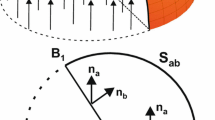Abstract
We prove a Gleason-type theorem for the quantum probability rule using frame functions defined on positive-operator-valued measures (POVMs), as opposed to the restricted class of orthogonal projection-valued measures used in the original theorem. The advantage of this method is that it works for two-dimensional quantum systems (qubits) and even for vector spaces over rational fields—settings where the standard theorem fails. Furthermore, unlike the method necessary for proving the original result, the present one is rather elementary. In the case of a qubit, we investigate similar results for frame functions defined upon various restricted classes of POVMs. For the so-called trine measurements, the standard quantum probability rule is again recovered.
Similar content being viewed by others
REFERENCES
S. Kochen and E. P. Specker, J. Math. Mech. 17, 59(1967).
A. M. Gleason, J. Math. Mech. 6, 885(1957).
C. A. Fuchs, “Quantum mechanics as quantum information (and only a little more),” quant-ph/0205039.
R. J. Greechie and D. J. Foulis, Int. J. Theor. Phys. 34, 1369(1995).
G. Ludwig, Foundations of Quantum Mechanics (Springer, Berlin, 1983).
K. Kraus, States, Effects, and Operations: Fundamental Notions of Quantum Theory, Lecture Notes in Physics, Vol. 190 (Springer, Berlin, 1983).
P. Busch, M. Grabowski, and P. Lahti, Operational Quantum Physics (Springer, Berlin, 1995); 2nd corrected printing, 1997.
P. Busch, “Resurrection of von Neumann's no-hidden-variables theorem,” quant-ph/ 9909073.
D. A. Meyer, Phys. Rev. Lett. 83, 3751(1999).
R. Clifton and A. Kent, Proc. Roy. Soc. London Ser. A 456, 2101(2000).
D. M. Appleby, Phys. Rev. A 65, 022105(2002).
A. Cabello, Phys. Rev. A 65, 052101(2002).
W. Tung, Group Theory in Physics (World Scientific, Philadelphia, 1993).
A. Peres, Quantum Theory: Concepts and Methods (Kluwer Academic, Dordrecht, The Netherlands, 1993).
A. Cabello, Phys. Rev. Lett. 90, 190401(2003).
G. M. D'Ariano and P. L. Presti, “Classical and quantum noise in measurements and transformations,” quant-ph/0301110.
M. A. Nielsen and I. L. Chuang, Quantum Computation and Quantum Information (Cambridge University Press, Cambridge, 2000).
Author information
Authors and Affiliations
Rights and permissions
About this article
Cite this article
Caves, C.M., Fuchs, C.A., Manne, K.K. et al. Gleason-Type Derivations of the Quantum Probability Rule for Generalized Measurements. Foundations of Physics 34, 193–209 (2004). https://doi.org/10.1023/B:FOOP.0000019581.00318.a5
Issue Date:
DOI: https://doi.org/10.1023/B:FOOP.0000019581.00318.a5




